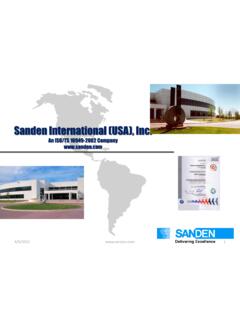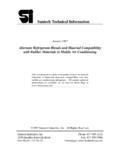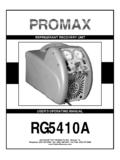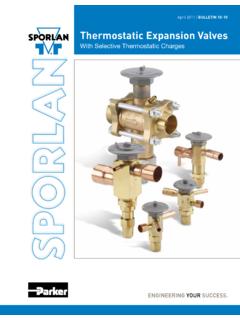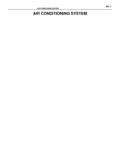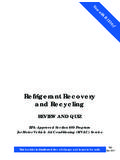Transcription of SD Service Guide Sept 08 - Sanden USA
1 SD Compressor Service Guide 2 TTaabbllee ooff CCoonntteennttss 1. Compressor Models Covered 2. Compressor Nomenclature 3. Cautionary Information Pressure Release Recovery of refrigerant Handling of refrigerant Ventilation Avoid use of Warranty for Recycled refrigerant 4. R134a Information R134a/PAG Oil Handling table of Saturation Temperatures and Pressure 5. Compressor Identification Label Date Codes 6. Application Specifications Belt Tension Speed Rating Basic Specifications Assembly Torques Mounting Compressor Rotation Ear Deflection Bending Recommended Pressure and Temperature Conditions Discharge Gas Condition Suction Gas Condition Ambient Temperature Clutch Oil Charge Oil Flow Theory Oil Charging
2 Passenger Car Light Duty Truck Single Evaporator Dual Evaporator Long Hose Systems System refrigerant charges greater than 56 oz (1600g) 7. Diagnosis Confirmation Of Compressor Failure Compressor Rotation Clutch Inspection Voltage Test Air Gap Test Coil Resistance Test Pressure or Pumping Test Leak Checking Visual Soap bubble Electronic Dyes Noise Non
3 Compressor 38. Compressor Repair Clutch Removal Clutch Installation Cylinder Head Replacement 9. Compressor Replacement Contamination Inspection Oil Amount (No Contamination) Oil Amount (Flushed System) 10. Service Procedures Flushing Equipment types Safety Acceptable Flushing Fluids Components to Flush Flushing Tips Removal of Residual Flushing Fluid Evacuation refrigerant Charge Charging Systems High Side Charging Low Side Charging System Oil Balance Oil flow In Laboratory Oil Amount Determination Oil Checking is Not Required Under Normal Conditions Circumstances When Oil Addition or Balancing is Required Oil Addition during Component Replacement 11.
4 Warranty Return Process Warranty Duration 12. Compressor Failure Causes Overheating Contamination Clutch Slippage Handling or Impact Damage 13. Tools Special Service Tools Standard Tools \ Compressor Models Covered Type R-134a R-12 SD7B10 SDB-706 SD7H13 SD-708 7 Cylinder SD7H15/ HD.
5 SHD SD-709 SD7B10 / SD5H09 SD-505 SD5H11 SD-507 SD5H14 SD-508 5 Cylinder SD-510 Compressor Nomenclature R-134a R-12 SD 7 H 15 HD HD- Heavy Duty SHD- Sealed HD Approximate Displacement In CC s divided by 10 Port Location B- Body H- Head Number of pistons Sanden wobble plate piston type compressor HD 15 H 7 SD SD-709 Approximate Displacement In Cubic Inches Number of pistons Sanden wobble plate piston type compressor 09 7 SD 5 Cautionary Information Pressure Release Before disconnecting any lines or removing the oil plug, always make sure refrigerant has been removed from the A/C system by recovering it with the appropriate recovery equipment.
6 When working on compressors, separate from the system, always be sure to relieve internal pressure first. Internal compressor pressure can be relieved by removing shipping caps / pads from both ports. Recovery of refrigerant Never discharge refrigerant to the atmosphere. Always use approved refrigerant recovery / recycling equipment to capture refrigerant which is removed from the A/C system. Do not mix refrigerants in the same piece of equipment; one should be designated for R-12 and another for R-134a. Handling of refrigerant Always wear eye and hand protection when working on an A/C system or compressor.
7 Liquid refrigerant can cause frostbite and / or blindness. Ventilation Keep refrigerants and oils away from open flames. Refrigerants can produce poisonous gasses in the presence of a flame. Work in a well-ventilated area. Avoid Use of Compressed Air Do not introduce compressed air into an A/C system due to the danger of contamination. Warranty for Recycled refrigerant The warranty offered by Sanden International ( ), Inc., on air conditioning compressors when used with recycled refrigerant will be the same as for new refrigerant provided that the following SAE standards are met: R-12 R134a refrigerant Purity J1990 J2099 Recycling Machine J1989 J2210, J2788 Note: Recycling machines must be validated to the appropriate SAE standard and by Underwriters Laboratories.
8 Recycled refrigerant from other sources must meet the appropriate ARI standards. Failure to comply with these provisions may void any warranty on the compressor. 6 R-134a Information R134a / PAG Oil Handling Precautions As a conscientious member of the global community, Sanden Corporation is committed to the elimination of CFC-based refrigerants. This manual focuses on Service information for Sanden compressors intended for use with R134a and PAG oils. 1. Always follow safety precautions described in section 2. Do not discharge R134a into the atmosphere. Even though its ozone depletion potential is zero, it does have global warming potential.
9 Recovery and recycling are mandated by the Clean Air Act. Use recovery equipment designated only for R134a. Never introduce another refrigerant into the R134a equipment. 3. Never mix R134a with other refrigerants or A/C systems failure may to occur. 4. Use only Sanden specified PAG lubricants for R134a systems using Sanden compressors. If other lubricants are used, A/C system failure is likely to occur. 5. The Sanden specified PAG oils used in R134a systems absorb atmospheric moisture very quickly. Moisture in the A/C system can cause major damage or failure. Never leave PAG oil exposed to air for a prolonged time.
10 Tightly reseal the oil container immediately after each use. During A/C system repair, cap all fittings as soon as opened and leave capped until just before they are reconnected. If a repair is performed on an R134a compressor or system, evacuate the system for at least 30 minutes before recharging to ensure the removal of moisture which may have been absorbed by the PAG oil in the compressor and system. table of Saturation Temperatures and Pressures (R-134a) Temp. (F) Pressure (psig) Temp. (F)Pressure (psig) Temp. (F) Pressure (psig) -40 in. Hg 25 22 105 135 -30 in. Hg 30 26 110 147 -20 in.





